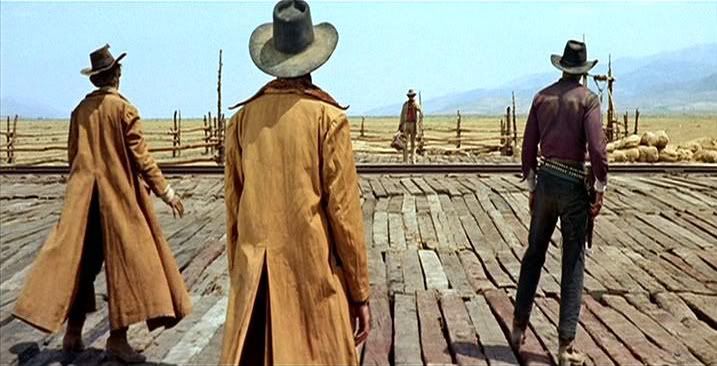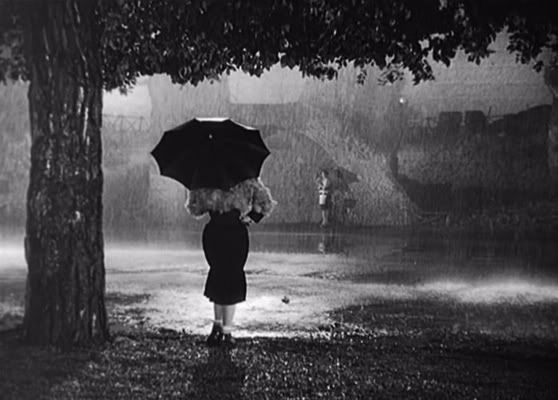
.:Film criticism by aesthetes for connoisseurs:.
| :: To search Sunset Blvd, use the Blogger bar at the top of the page :: |
| [::..resources..::] |
| :: imdb |
| :: box office mojo |
| :: foreign films |
| :: turner classic movies |
| :: british film institute |
| :: american film institute |
| :: culture vulture |
| :: screenwriter's utopia |
| :: screenplays |
| :: movie physics |
| :: auteur |
| :: the macguffin |
| :: strictly film school |
| [::..critics..::] |
| :: ebert |
| :: metacritic |
| :: rotten tomatoes |
| :: milk plus |
| [::..archives..::] |
:: 3.27.2005 ::
Cinema Sound Byte:: 2.25.2005 ::
Hannah: "I thought we had a date tonight, not a rehearsal! I should have known better than to expect you to act like a human being. You're nothing but a pair of dancing shoes! I'm getting tired of being a prop around here—when I'm with you I don't even feel like a girl! You're not even a human being—you're nothing but a pair of dancing shoes!"From Easter Parade, starring Judy Garland & Fred Astaire
Don: "You said that."
Hannah: "I don't care. Besides, I bought a new dress."
Don: "It's very pretty."
Hannah: "How do you know? You haven't even looked at me."
Don: "Oh, that's not true, I..."
Hannah: "Oh, isn't it? All right then, tell me. [closing her eyes] What color are my eyes? You won't be able to answer that because you have never paid enough attention to it—"
[He silences her with a kiss, causing her to open her eyes in surprise]
Don: "They're brown."
:: Posted by Laurie @ 11:09 AM [+] ::
...
Old Hollywood Glamour:: 2.21.2005 ::
I believe that in the future all who look back on 20th century American art will turn their eyes at some point to Hollywood. If you want to know why I believe that, Virginia Postrel's slide-show essay on photographer George Hurrell isn't a bad place to start:In the stills he took from 1929 until he was drafted in 1942, languid ladies' downcast eyes are framed with impossibly long eyelashes (painted on the negative by the photographer). Light bounces from satin, lacquer, and bright tresses sprawled across the floor. Shadow and reflection create mystery, inviting viewers to fill in the unseen details according to their own desires.Beautifully done.
:: Posted by Laurie @ 10:37 AM [+] ::
...
The Strangest Gunslinger in the West:: 2.15.2005 ::
I give up. I've decided I like westerns. Love them, even.
Shane (1953) is another movie I am drawn to because of its strangeness. Upon reflection, I think a lot of what makes it great is accidental rather than intentional. (That's not to say George Stevens was not a good director; after all, the history of film—and all art—is littered with many happy accidents, and that doesn't take away from anyone's talent.) Shane was meant to be a fairly conventional western, and yet it ended up becoming much more.
Stevens put a lot of thought into what he wanted this movie to look like, and it shows. But according to the IMDb, he spent only a few minutes choosing the actors to play the principal characters, and that's how we end up with such an unconventional hero. Alan Ladd was cast as Shane, the wandering gunslinger, reluctant to fight but deadly when pushed. At only 5'6", Ladd was too slim and elegant to be physically imposing; as a result, Shane's toughness and invincibility come across as mysterious, almost supernatural.
That's one of the main reasons why Shane is unlike any other movie. Another is the decision to cast Jack Palance, in one of his earliest roles, as Wilson, the villain of the piece—a grinning, merciless gunslinger dressed all in black. According to the DVD commentary, Palance wasn't yet comfortable with horses and practiced tirelessly, but even so, Stevens had a hard time getting some of the scenes he wanted. For instance, in the scene in which Wilson and Shane size each other up when they first meet, Wilson gets off his horse and walks over to get a drink of water, then gets back on his horse, never taking his eyes off Shane the entire time.
The problem arose when Stevens wanted Palance to get on the horse "like a cat," a feat that was apparently beyond his abilities at that point. So they used the shot of Palance getting off the horse and simply reversed it to show him getting back on the horse. It's a neat trick; on the surface, the scene looks natural, if odd—but on some level, I believe, the brain registers the unnaturalness of the movement, giving everything an elusive air of barely perceptible eeriness.
The whole movie is like that. The striking visuals and peculiar mood overtake the conventional plot, turning Shane into something special indeed.
:: Posted by Laurie @ 11:33 PM [+] ::
...
Cinema Still Life:: 2.09.2005 ::
From Fellini's The Nights of Cabiria
:: Posted by Laurie @ 8:53 PM [+] ::
...
Inside the Landscape
After I finished watching Tarkovsky's Solaris (1972) for the second time, I was struck once again by how utterly captivating Natalya Bondarchuk is as an otherworldly creature who, though she only appears to be human, somehow seems to become human before our very eyes.
I was even more amazed by her performance when I learned from her interview on the DVD that she was only 18 at the time of filming. Bondarchuk has a lot of other interesting things to say, but I particularly liked this (taken from the subtitles):If we just look at a landscape, that's a documentary. But if we start seeing and hearing something else, what the artist makes possible for us to see, that is art, and it bewitches us. But it affects only those who have it inside themselves, who have already accumulated so much in their soul that they can take it in.She goes on to say that this is why Tarkovsky's films are not for everyone. I can certainly see why Solaris might leave some confused or frustrated, but at the same time, I don't think it's nearly as abstruse as it may seem. So much of the imagery is both accessible and meaningful: A woman contemplating her reflection in a mirror and realizing for the first time, "This is me." A roiling, inscrutable cosmic sea that may or may not be aware of everything it is causing to happen. A man and a woman sharing a few moments of transcendence, hanging weightless in the air, touching only each other.
Solaris is flawed, difficult, and deeply strange. But in spite of the strangeness—perhaps because of it—there is much to bewitch us.
:: Posted by Laurie @ 11:23 PM [+] ::
...
Cinema Sound Byte:: 1.31.2005 ::
[Slim kisses Steve]From To Have and Have Not, screenplay by Jules Furthman & William Faulkner
Steve: What did you do that for?
Slim: I've been wondering if I'd like it.
Steve: What's the decision?
Slim: I don't know yet.
[They kiss again]
Slim: It's even better when you help.
:: Posted by Laurie @ 1:27 PM [+] ::
...
Something to Do With Death:: 1.26.2005 ::
For a long time I didn’t like westerns; they were too simplistic, too moralistic, too sentimental for my tastes. Then I discovered Sergio Leone, the Italian director best known for his spaghetti westerns starring Clint Eastwood. Leone loved westerns—he grew up watching them—and Once Upon a Time in the West (1968) is both an homage to those old Hollywood westerns and a ruthlessly unsentimental reinvention of the Western myth itself.
In the opening scene, Leone sets a pace that is somehow both leisurely and unbearably tense. Three dusty gunfighters arrive at an isolated, empty train station in the Arizona desert. They are waiting for something, and as they wait, the tension mounts and time crawls at an excruciatingly slow rate. Once Upon a Time in the West is a movie in which the score, composed by Ennio Morricone, plays an unusually significant role—the main characters even have their own themes—but there is no music (and no dialogue, either) in the opening sequence, just amplified natural sounds: a door banging, a windmill squeaking, a fly buzzing, knuckles cracking, water dripping. Then—finally—the whistle of an oncoming train.
And as the train pulls away, we see the first of four key characters—a nameless drifter (Charles Bronson) standing alone, drawing out mournful notes on a harmonica. This, it seems, is who the gunfighters have been waiting for. They draw their guns at last, but it’s the enigmatic newcomer who remains standing.

The scene that follows is even more fraught with tension, and the denouement is truly horrific. A family prepares for the homecoming of the patriarch’s new bride, but an ominous foreboding hangs over what should be a tranquil domestic scene. When shots finally ring out, it’s almost a relief. The brutal massacre of the family is over within seconds, and five men wearing dusters emerge from the sagebrush, faces concealed. Slowly, slowly, the camera pans up to the face of the gang’s leader, and when we first see the icy blue eyes of the killer (Henry Fonda), we know right away what kind of man he is—the kind who smiles as he shoots a child.
Next we see another train arriving—this one carrying the heartbreakingly lovely Jill (Claudia Cardinale), blissfully unaware of what has just happened to her new family and ready to begin her life on the frontier. When she realizes there is no one at the station to meet her, she finds a wagon to take her to her destination, a place in the middle of nowhere called Sweetwater. The wagon stops at a sprawling way station, where we meet the final key character, a dangerous yet boyishly charming bandit named Cheyenne (Jason Robards), who prowls in after shooting his captors.
Is he a hero, or is he a villain? What about the harmonica-playing loner, who turns out to be inside the way station as well, concealed in the shadows? And what has led these people to cross paths in the first place? What does it all mean? We don’t know yet, and we don’t learn for a long time. When we do find out—eventually, all is revealed—it’s not from the characters talking about themselves or each other. Leone was a director who knew that a facial expression is worth a thousand lines of dialogue, often bringing the camera up very close to the actors’ faces. Instead of words, words, words, the story emerges through expression and gesture, music and silence, sound and image.
The action unfolds in no hurry whatsoever, and each scene brims with fascinating detail. In Once Upon a Time in the West, time slows down; like the clock in one scene that’s missing most of its numbers, time even seems to cease existing altogether. This is simply not a movie for those seeking immediate gratification—but for the patient, an embarrassment of riches awaits.
:: Posted by Laurie @ 6:34 PM [+] ::
...
Metacriticism
Oscar time naturally makes one look back to assess the year in film. So what were the best-reviewed movies of 2004? Metacritic breaks it down.
And because I never really get tired of scrolling down lists of movie titles, I'm finding Metacritic's list of All-Time High Scores diverting as well. The number one movie? The Godfather.
:: Posted by Laurie @ 5:01 PM [+] ::
...
